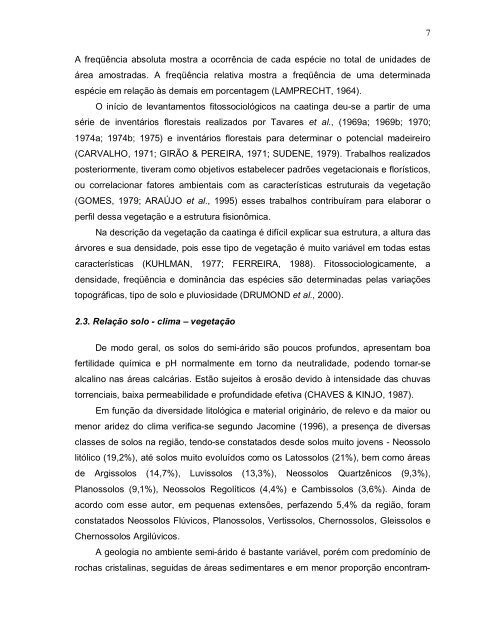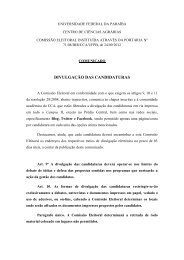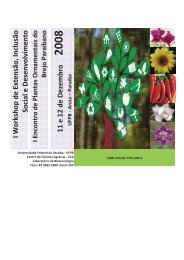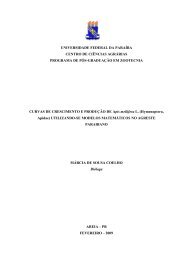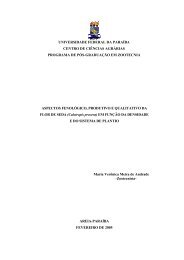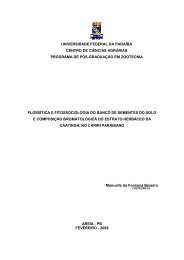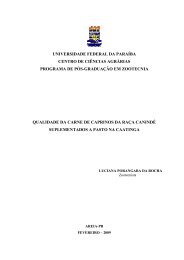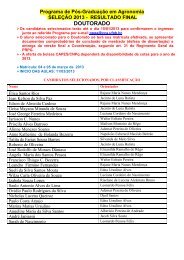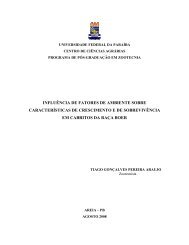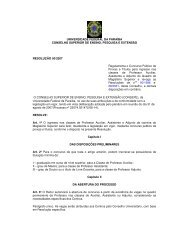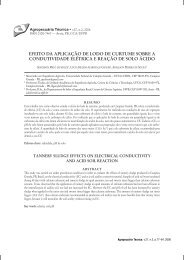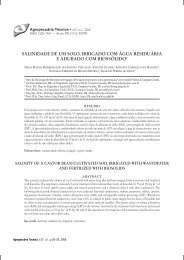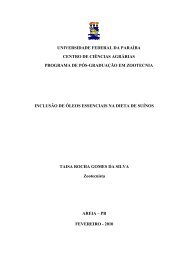Estrutura da vegetação e distribuição espacial do Licuri, Syagrus ...
Estrutura da vegetação e distribuição espacial do Licuri, Syagrus ...
Estrutura da vegetação e distribuição espacial do Licuri, Syagrus ...
Create successful ePaper yourself
Turn your PDF publications into a flip-book with our unique Google optimized e-Paper software.
A freqüência absoluta mostra a ocorrência de ca<strong>da</strong> espécie no total de uni<strong>da</strong>des de<br />
área amostra<strong>da</strong>s. A freqüência relativa mostra a freqüência de uma determina<strong>da</strong><br />
espécie em relação às demais em porcentagem (LAMPRECHT, 1964).<br />
O início de levantamentos fitossociológicos na caatinga deu-se a partir de uma<br />
série de inventários florestais realiza<strong>do</strong>s por Tavares et al., (1969a; 1969b; 1970;<br />
1974a; 1974b; 1975) e inventários florestais para determinar o potencial madeireiro<br />
(CARVALHO, 1971; GIRÃO & PEREIRA, 1971; SUDENE, 1979). Trabalhos realiza<strong>do</strong>s<br />
posteriormente, tiveram como objetivos estabelecer padrões vegetacionais e florísticos,<br />
ou correlacionar fatores ambientais com as características estruturais <strong>da</strong> <strong>vegetação</strong><br />
(GOMES, 1979; ARAÚJO et al., 1995) esses trabalhos contribuíram para elaborar o<br />
perfil dessa <strong>vegetação</strong> e a estrutura fisionômica.<br />
Na descrição <strong>da</strong> <strong>vegetação</strong> <strong>da</strong> caatinga é difícil explicar sua estrutura, a altura <strong>da</strong>s<br />
árvores e sua densi<strong>da</strong>de, pois esse tipo de <strong>vegetação</strong> é muito variável em to<strong>da</strong>s estas<br />
características (KUHLMAN, 1977; FERREIRA, 1988). Fitossociologicamente, a<br />
densi<strong>da</strong>de, freqüência e <strong>do</strong>minância <strong>da</strong>s espécies são determina<strong>da</strong>s pelas variações<br />
topográficas, tipo de solo e pluviosi<strong>da</strong>de (DRUMOND et al., 2000).<br />
2.3. Relação solo - clima – <strong>vegetação</strong><br />
De mo<strong>do</strong> geral, os solos <strong>do</strong> semi-ári<strong>do</strong> são poucos profun<strong>do</strong>s, apresentam boa<br />
fertili<strong>da</strong>de química e pH normalmente em torno <strong>da</strong> neutrali<strong>da</strong>de, poden<strong>do</strong> tornar-se<br />
alcalino nas áreas calcárias. Estão sujeitos à erosão devi<strong>do</strong> à intensi<strong>da</strong>de <strong>da</strong>s chuvas<br />
torrenciais, baixa permeabili<strong>da</strong>de e profundi<strong>da</strong>de efetiva (CHAVES & KINJO, 1987).<br />
Em função <strong>da</strong> diversi<strong>da</strong>de litológica e material originário, de relevo e <strong>da</strong> maior ou<br />
menor aridez <strong>do</strong> clima verifica-se segun<strong>do</strong> Jacomine (1996), a presença de diversas<br />
classes de solos na região, ten<strong>do</strong>-se constata<strong>do</strong>s desde solos muito jovens - Neossolo<br />
litólico (19,2%), até solos muito evoluí<strong>do</strong>s como os Latossolos (21%), bem como áreas<br />
de Argissolos (14,7%), Luvissolos (13,3%), Neossolos Quartzênicos (9,3%),<br />
Planossolos (9,1%), Neossolos Regolíticos (4,4%) e Cambissolos (3,6%). Ain<strong>da</strong> de<br />
acor<strong>do</strong> com esse autor, em pequenas extensões, perfazen<strong>do</strong> 5,4% <strong>da</strong> região, foram<br />
constata<strong>do</strong>s Neossolos Flúvicos, Planossolos, Vertissolos, Chernossolos, Gleissolos e<br />
Chernossolos Argilúvicos.<br />
A geologia no ambiente semi-ári<strong>do</strong> é bastante variável, porém com pre<strong>do</strong>mínio de<br />
rochas cristalinas, segui<strong>da</strong>s de áreas sedimentares e em menor proporção encontram-<br />
7


